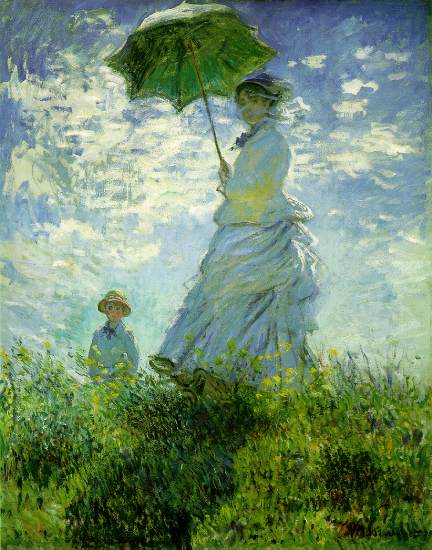In this case, I would like to recall Monet's The Stroll, referenced in my weekly reflection 1. The following is a dialogue (practically a monologue) written for The Stroll in an attempt to un-habituate Monet's neutrality.
 "The bastard is dead," the lady says, wielding her umbrella high, as if a harbinger with sword. "He can't hurt us any longer, Chris, dear."
"The bastard is dead," the lady says, wielding her umbrella high, as if a harbinger with sword. "He can't hurt us any longer, Chris, dear.""Mommy," Chris spoke with hesitation, keeping his distance.
"I know what I did was drastic, some might say, wrong. What other option was there? 'Till death' ... the preacher says. But, who is he to talk? A man who makes his career talking, not thinking, has nothing to say. Paradoxical, isn't it? Reality is not so kind as to follow the prescriptions of heaven, though it would be nice. In that case, 'till death' sounded more like a prophecy waiting to be fulfilled to me. I'm a fugitive now - a cold blooded murderer, according to law. Yet, it was merely defense. Physically, I am pristine, but emotionally, the pain runs deep. A court would never accept that. There was no way out. I could have ran, but where is the justice in that? There is a breech between law and justice. It is because of that that I can't show my face again. I now forever don a mask. But everyone has a face that they won't show anybody else. I'm no different. We're all fake to ensure our own survival. It's anarchy - no structure. It's ..."
At that moment, she was cut off by Chris' words, "Mom, I want to go. I want to run."
"Good. Let's go, we'll be okay." The lady offered an accomplished smile.
--
Dealing with this same Monet painting, the Structuralist analysis of art may also be applied. According to the works of Ferdinand de Saussure and Jonathan Culler, the Structuralist analyzes literature, and indeed all language, by the "signs" found in it. A sign has two parts: a 'signifier' and a 'signified.' A signifier is an arbitrary thing that refers to a real thing. For example, the word "tree" refers to a real plant. A signified is simply that real plant - it is what ever the signifier refers to.
Saussure called this method of analyzing signs "semiotic analysis."
In exhibition of the Structuralist analysis, the following is a semiotic analysis of Monet's The Stroll, which, due to the discussed neutrality above, is quite challenging.
A major focal point are the outfits of the figures. The lady is especially well dressed in clean and historically classy dress, signifying that these people are wealthy, or higher class individuals. The lady is pictured with a similarly dressed young boy, who looks to the lady with patience, signifying possible maternal relationship between the figures. It should be added here that we know the young figure is a boy because his haircut signifies masculinity. The lady is in a large, traditional dress, which signifies a traditional social setting, or family. This also signifies the existence of a father-husband figure that is absent in the painting. The lady's umbrella further signifies the traditional family, because it signifies the importance of the pure, white, chaste ideal of traditional wives that often is falsely attributed to skin tone. Lastly, the figures seem to be staring down at the audience, signifying the figures' characters as haughty, up-tight, or arrogant.


No comments:
Post a Comment